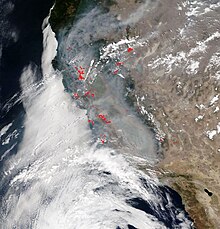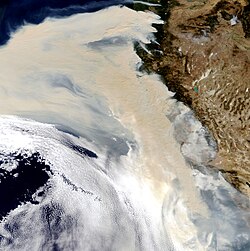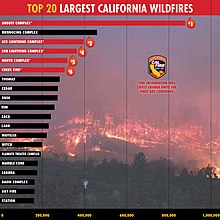August 2020 California lightning wildfires
| August 2020 California lightning wildfires | |
|---|---|
 NASA satellite image of the wildfires on August 24, 2020 | |
| Date(s) | August 11, 2020 – January 5, 2021 |
| Location | California |
| Statistics[2] | |
| Total fires | 650[1] |
| Total area | Over 2,529,000 acres (1,023,450 ha)[1] |
| Impacts | |
| Deaths | 23[3] |
| Non-fatal injuries | 43 |
| Structures destroyed | 3,586+ |
| Damage | Unknown |
| Ignition | |
| Cause | Lightning |
| 2020 Western U.S. wildfires |
|---|
 |
A series of 650 wildfires ignited across Northern California in mid-August 2020, due to a siege of dry lightning from rare, massive summer thunderstorms, which were caused by an unusual combination of very hot, dry air at the surface, dry fuels, and advection of moisture from the remains of Tropical Storm Fausto northward into the Bay Area.[4][5] These fires burned between 1,500,000 acres (6,100 km2) to 2,100,000 acres (8,500 km2) within a 2–3 week period. The August 2020 lightning fires included three enormous wildfires: the SCU Lightning Complex, the August Complex, and the LNU Lightning Complex. On September 10, 2020, the August Complex set a record for the single-largest wildfire in the modern history of California, reaching a total area burned of 471,185 acres (1,907 km2). On September 11, the August Complex merged with the Elkhorn Fire, another massive wildfire of 255,039 acres (1,032 km2), turning the August Complex into a monster wildfire of 746,607 acres (3,021 km2).[6]
The three major Bay Area fires, the SCU, LNU, and the CZU Lightning Complex, collectively burned about 846,000 acres (3,420 km2) by mid-September 2020, destroyed 2,723 structures, and took 6 lives.[7]
Meteorological background
[edit]
Between August 14 and August 16, Northern California was subjected to record-breaking warm temperatures,[8][9][10] due to anomalously strong high pressure over the region. Early on August 15, the National Weather Service for San Francisco issued a Fire Weather Watch[11] highlighting the risk of wildfire starts due to the combination of lightning risk due to moist, unstable air aloft, dry fuels, and hot temperatures near the surface. Later that day, the Fire Weather Watch was upgraded to a Red Flag Warning,[12] noting the risk of abundant lightning already apparent as the storms moved toward the region from the south.
The source of this plume of moist, unstable air was the weakening Tropical Storm Fausto. Due to abnormal winds, this plume was streaming from up to 1,000 miles (1,600 km) off the coast of the Baja Peninsula into Northern California. This moisture then interacted with a high-pressure ridge situated over Nevada that was bringing a long-track heat wave to much of California and the West.[13] These colliding weather systems then created excessive atmospheric instability that generated massive thunderstorms throughout much of Northern and Central California. Such thunderstorms are rare for California, but were more typical of Midwest garden-variety storms, with one location near Travis Air Force Base going from around 80 °F (27 °C) to 100 °F (38 °C) in nearly 1–2 hours.[14] Additionally, much of these storms were only accompanied with dry lightning and produced little to no rain, making conditions very favorable for wildfires to spark and spread rapidly.[15]
Early morning on August 16, when the first thunderstorms hit, around 2,500 lightning strikes hit the Bay Area, with 200 strikes happening in 30 minutes at one point, which the National Weather Service office in Bay Area labelled as "insane".[16] Within the next 72–96 hours, over 12,000 lightning strikes were recorded over Northern California. These lightning strikes sparked up to 585 wildfires, many of which grew to be very large at a rapid pace due to parched brush, especially in Northern California.[13]
A second wave of thunderstorms was forecasted to hit on August 23 and 24; however, they failed to materialize over the Bay Area, which has been most impacted by these fires, and instead just produced light rain and a few lightning strikes over the Sierra Nevada, barely having any impact.[17]
Fires
[edit]Many of the fires were started or discovered on August 16 or 17:
| Name | County | Acres | Start date | Containment date | Notes | Ref |
|---|---|---|---|---|---|---|
| Wolf | Tuolumne | 2,057 | August 11 | November 20 | Lightning-sparked | [18] |
| Lake | Los Angeles | 31,089 | August 12 | September 28 | Lightning-sparked, 33 structures destroyed; 6 damaged; 21 outbuildings destroyed; 2 injuries | [19][20][21] |
| Hills | Fresno | 2,121 | August 15 | August 24 | Lightning-sparked; 1 fatality | [22] |
| Loyalton | Lassen, Plumas, Sierra | 47,029 | August 15 | September 14 | Lightning-sparked, Caused National Weather Service to issue first ever Fire Tornado Warning; 5 homes, 6 outbuildings destroyed | [23][24] |
| River | Monterey | 48,088 | August 16 | September 4 | Caused by a lightning strike, 4 injuries | [25] |
| Dome | San Bernardino | 43,273 | August 16 | September 14 | Caused by a lightning strike, burned in the Mojave National Preserve | [26] |
| Beach | Mono | 3,780 | August 16 | August 28 | Caused by a lightning strike | [27] |
| SCU Lightning Complex | Santa Clara, Alameda, Contra Costa, San Joaquin, Merced, Stanislaus | 396,624 | August 16 | October 1 | Deer Zone, Marsh, Canyon Zone and other surrounding fires combined into one multi-fire incident by CalFire; all believed to have been sparked by an intense and widespread lightning storm; 136 structures destroyed; 26 structures damaged; 5 injuries. | [28] |
| August Complex | Glenn, Mendocino, Lake, Tehama, Trinity | 1,032,648 | August 16 | November 12 | Lightning strikes started 37 fires and the Elkhorn Fire, several of which grew to large sizes, especially the Doe Fire; the fire merged with the Elkhorn Fire on September 11, becoming the largest recorded wildfire in California history. 933 structures destroyed; 2 injuries; 1 fatality | [29][6] |
| CZU Lightning Complex | San Mateo, Santa Cruz | 86,509 | August 16 | September 22 | Several lightning-sparked fires burning close together across San Mateo and Santa Cruz Counties; 1,490 structures destroyed; 140 structures damaged; 1 injury; 1 fatality. | [30] |
| Rattlesnake | Tulare | 8,419 | August 16 | December 29 | Lightning sparked a slow-growing fire in inaccessible terrain. | [31] |
| LNU Lightning Complex | Colusa, Lake, Napa, Sonoma, Solano, Yolo | 363,220 | August 17 | October 2 | Multi-fire incident that includes the Hennessey Fire (305,651 acres), the Walbridge Fire (55,209 acres), and the Meyers Fire (2,360 acres) sparked by lightning; 1,491 structures destroyed; 232 structures damaged; 4 injuries; 6 fatalities.[32] It is the fifth-largest fire complex in California history. | [33] |
| Butte/Tehama/Glenn Lightning Complex (Butte Zone) | Butte | 19,609 | August 17 | October 16 | Lightning sparked 34 fires throughout Butte County | [34] |
| North Complex | Plumas, Butte | 318,935 | August 17 | December 4 | Lightning strikes, includes the Claremont Fire and the Bear Fire; 2,471 structures destroyed; 31 structures damaged; 16 fatalities; 13 injuries; It is the sixth-largest fire in modern California history. | [35] |
| Jones | Nevada | 705 | August 17 | August 28 | Lightning sparked, 21 structures destroyed, 3 structures damaged, 7 injuries | [36] |
| Sheep | Plumas, Lassen | 29,570 | August 17 | September 9 | Lightning-sparked, 26 structures destroyed, 1 injury | [37][38] |
| Salt | Calaveras | 1,789 | August 18 | August 24 | Lightning-sparked | [39] |
| W-5 Cold Springs | Lassen | 84,817 | August 18 | September 14 | Lightning-sparked | [40] |
| Carmel | Monterey | 6,905 | August 18 | September 4 | Lightning-sparked, 73 structures destroyed; 7 structures damaged | [41] |
| Woodward | Marin | 4,929 | August 19 | October 2 | Lightning-sparked, 1,600 structures threatened | [42] |
| SQF Complex | Tulare | 174,178 | August 19, 2020 | January 5, 2021 | Lightning-sparked, contains the Castle Fire (168,913 acres) and the Shotgun Fire (841 acres) | [43] |
| Moc | Tuolumne | 2,857 | August 20 | August 30 | Lightning-sparked | [44] |
CZU Lightning Complex
[edit]
By August 20, the fire had caused extensive damage to the Big Basin Redwoods State Park. The towns of Pescadero and La Honda were threatened by flames.[45]
LNU Lightning Complex
[edit]The LNU Lighting Complex was a complex of 7 different fires in the Sonoma, Lake, and Napa counties, with 4 major ones being the Hennessey, Gamble, 15-10, and 13-4 Fires. It first sparked around 6:37 AM on August 17, when a lightning storm passed over the Lake Hennessey area. Another lightning strike occurred at 6:39, near the Aonair winery, starting a fire that was 5 acres large.[46] About 60 fires had sparked in the region during that time period, however, while some blazes were quickly contained at 1 or 2 acres, others rapidly went out of control. Around 9 AM, dry, gale-force winds between 20 and 40 miles per hour helped to fan the flames of two uncontrolled blazes, the Gamble Fire and the Hennessey Fire. This caused the Hennessey Fire to explode to 2,400 acres (9.7 km2) by 5 PM August 17, prompting several evacuations.[47] By the night of August 18, the LNU complex had burned a total of 32,025 acres (129.60 km2) so far with no containment. 3 structures were destroyed, and the two biggest fires, the Hennessey and the Gamble Fires, both expanded to 10,000 acres (40 km2).[48] On August 19, the fire raced fast towards Vacaville, and caused hundreds of evacuations. Many people fled the city with only their basic necessities, with police officers and firefighters going door to door warning people to evacuate.[49] By August 20, the LNU fire had burned 215,000 acres (870 km2) and destroyed 480 structures. It forced the evacuation of some personnel in the Travis Air Force Base and the city of Healdsburg, California, that had already evacuated previously during the Tubbs Fire and the Kincade Fire.[45]
SCU Lightning Complex
[edit]The SCU Lightning Complex was a cluster of 20 different fires in the Santa Clara, Contra Costa, Alameda, Stanislaus, and San Joaquin counties, that was divided into 3 different zones - the Deer Zone, Calaveras Zone, and Canyon Zone. By August 18, the fires had expanded to over 35,000 acres (140 km2) with only 4 percent containment.[48] By August 20, the fire burned 140,000 acres (570 km2) and was 5% contained, evacuating people in the East San Jose foothills,[50] and threatening the Lick Observatory with flames.[45] On August 21, the SCU fire had exploded overnight by more than 40%, reaching a total of 230,000 acres (930 km2) and being 10% contained.[51]
Impacts
[edit]The North Complex fire's Bear Fire had destroyed the town of Berry Creek. The SCU Lightning Complex fires have threatened the cities of Fremont, Milpitas, Patterson, and San Jose, and also threatened Lick Observatory.
Evacuations
[edit]This section is empty. You can help by adding to it. (December 2020) |
Air quality and smoke pollution
[edit]On September 9, 2020, the sky appeared orange across the Bay Area due to wildfire smoke.
See also
[edit]References
[edit]- ^ a b Vera, Amir; Lynch, Jamiel (August 23, 2020). "Deadly California wildfires scorch more than 1 million acres with no end in sight". CNN. Retrieved August 24, 2020.
- ^ "California Daily Wildfire Update". CAL FIRE. August 25, 2020. Retrieved August 26, 2020.
- ^ Batey, Eve (August 24, 2020). "At Least Seven Dead and 1.1 Million Acres Burned in California Wildfires". Eater SF. Retrieved August 24, 2020.
- ^ "Cal Fire 72 hour activity". twitter.com. Retrieved August 20, 2020.
- ^ "Moisture from Tropical Storm Fausto fuels NorCal thunderstorms". KTLA. August 16, 2020. Retrieved August 16, 2020.
- ^ a b Michele Chandler (September 11, 2020). "What we know Thursday about North State fires: Elkhorn merges with August Complex to create 726K-acre monster". Redding.com. Redding Record Searchlight. Retrieved September 11, 2020.
- ^ "'Minimal Fire' In Santa Cruz Mountains CZU Complex; LNU, SCU Complexes Near Total Containment". CBS Bay Area. September 15, 2020. Retrieved September 15, 2020.
- ^ "Record Event Report". mesonet.agron.iastate.edu. National Weather Service. August 14, 2020. Retrieved September 8, 2020.
- ^ "Record Event Report". mesonet.agron.iastate.edu. National Weather Service. August 15, 2020. Retrieved September 8, 2020.
- ^ "Record Event Report". mesonet.agron.iastate.edu. National Weather Service. August 16, 2020. Retrieved September 8, 2020.
- ^ "Urgent Fire Weather Message". mesonet.agron.iastate.edu. National Weather Service. August 15, 2020. Retrieved September 8, 2020.
- ^ "Urgent Fire Weather Message". mesonet.agron.iastate.edu. National Weather Service. August 15, 2020. Retrieved September 8, 2020.
- ^ a b Boxall, Bettina (August 23, 2020). "'Fires of hell': How dry lightning has sparked some of California's biggest infernos". Los Angeles Times. Retrieved August 25, 2020.
- ^ "Record heat, unprecedented lightning fire siege in Northern California; more dry lightning to come". Weather West. August 21, 2020. Retrieved August 28, 2020.
- ^ Simmons, Rusty (August 16, 2020). "What's behind this once-in-a-decade Bay Area thunderstorm?". San Francisco Chronicle. Retrieved August 25, 2020.
- ^ Nicco, Mike; Tuma, Drew; Argen, Lisa (August 17, 2020). "More lightning, thunderstorms hit Bay Area as heat wave continues". ABC7 San Francisco. Retrieved September 1, 2020.
- ^ Fagan, Kevin (August 24, 2020). "Weekend lightning spares Bay Area, but destruction from 'megafires' continues". San Francisco Chronicle. Retrieved August 25, 2020.
- ^ "Wolf Fire Information". inciweb.nwcg.gov. November 20, 2020. Retrieved January 13, 2021.
- ^ "Lake Fire Information". inciweb.nwcg.gov. August 12, 2020.
- ^ "Lake Fire". fire.ca.gov. August 12, 2020.
- ^ "CAL FIRE California Statewide Fire Summary for Tuesday Morning, September 29, 2020". September 29, 2020.
- ^ "Hills Fire Information". fire.ca.gov. August 17, 2020.
- ^ "Loyalton Fire Information". inciweb.nwcg.gov. September 14, 2020. Retrieved October 5, 2020.
- ^ @NWStornado (August 16, 2020). "Loyalton Fire Tornado Warning" (Tweet) – via Twitter.
- ^ "River Fire Information". fire.ca.gov. September 4, 2020.
- ^ "Dome Fire Information". inciweb.nwcg.gov. September 14, 2020.
- ^ "Beach Fire Information". inciweb.nwcg.gov. August 28, 2020.
- ^ "SCU Lightning Complex Fires Information". fire.ca.gov. October 1, 2020. Archived from the original on September 22, 2020. Retrieved August 22, 2020.
- ^ "August Complex Fire Information". inciweb.nwcg.gov. January 6, 2021. Retrieved January 13, 2021.
- ^ "CZU August Lightning Complex Fires Information". fire.ca.gov. September 22, 2020.
- ^ "Rattlesnake Fire Information". inciweb.nwcg.gov. December 29, 2020. Retrieved January 13, 2021.
- ^ "Northern California Wildfires: Where To Find Updates On Air Quality, Evacuations, And Official Information". CapRadio. October 2, 2020. Retrieved October 2, 2020.
- ^ "LNU Lightning Complex Fire Fires Information". fire.ca.gov. September 22, 2020. Archived from the original on September 22, 2020. Retrieved August 22, 2020.
- ^ "Butte Lightning Complex Fires Information". fire.ca.gov. October 16, 2020. Archived from the original on October 4, 2020. Retrieved October 27, 2020.
- ^ "North Complex Fire Information". inciweb.nwcg.gov. December 7, 2020. Retrieved January 13, 2021.
- ^ "Jones Fire | Welcome to CAL FIRE". www.fire.ca.gov. Retrieved August 25, 2020.
- ^ "Sheep Fire Information". inciweb.nwcg.gov. September 4, 2020.
- ^ "Sheep Fire Information". fire.ca.gov. August 22, 2020.
- ^ "Salt Fire Information". fire.ca.gov. August 19, 2020.
- ^ "W-5 Cold Spring Fire Information". inciweb.nwcg.gov. September 14, 2020.
- ^ "Caramel Fire Information". fire.ca.gov. August 19, 2020.
- ^ "Woodward Fire Information". inciweb.nwcg.gov. October 2, 2020.
- ^ "SQF Complex Fire Information". inciweb.nwcg.gov. January 5, 2021. Retrieved January 13, 2021.
- ^ "Moc Fire Information". fire.ca.gov. August 20, 2020.
- ^ a b c Lin II, Rong-Gong (August 20, 2020). "At least 5 dead, nearly 700,000 acres burned as massive fires threaten Northern and Central California". Los Angeles Times. Retrieved October 8, 2020.
- ^ Gafni, Matthias; Johnson, Lizzie (September 3, 2020). "A lightning fire, a thunderous path". San Francisco Chronicle. Retrieved October 12, 2020.
- ^ Barnard, Cornell W. (August 18, 2020). "Some Napa County residents choose to stay despite evacuation orders as Hennessey Fire explodes in size". KGO-TV. Retrieved October 14, 2020.
- ^ a b "Fires raging out of control in Bay Area prompt evacuations". KRON 4 News. August 18, 2020. Retrieved October 10, 2020.
- ^ Fracassa, Dominic; Tucker, Jill (August 19, 2020). "Homes burn, residents flee for lives as lightning-sparked fire rages northwest of Vacaville". San Francisco Chronicle. Retrieved October 10, 2020.
- ^ Jennifer, Wadsworth (August 20, 2020). "SCU Complex Grows to 140,000 Acres; Just 5 Percent Contained". San Jose Inside. Retrieved October 10, 2020.
- ^ Wadsworth, Jennifer (August 21, 2020). "Overnight Growth Makes SCU Complex California's Biggest Fire". San Jose Inside. Retrieved October 10, 2020.

